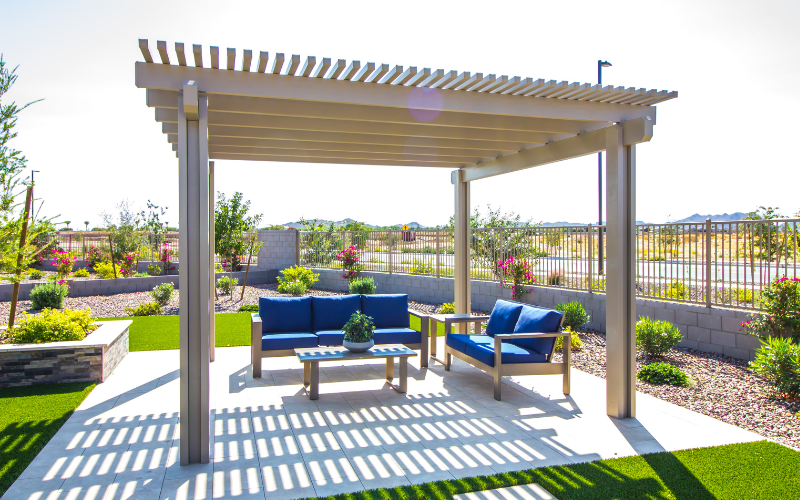Pergolas are a versatile and beautiful addition to any outdoor space, but adding a roof can increase both their utility and aesthetic appeal. Whether you’re looking to protect your patio from rain or provide more substantial shade, building a pergola with a roof requires careful planning and thoughtful execution. In this detailed guide, you will learn everything from the correct roof slope for drainage to choosing the right materials. Additionally, you’ll find step-by-step instructions on attaching a pergola to your house, building a roof, and selecting the best wood for your project.
How Much Slope Should a Pergola Roof Have to Drain Water Properly?
One of the most important considerations when building a pergola roof is ensuring proper drainage. A flat roof may look sleek and modern, but without a slope, water can pool on the roof surface, leading to damage and leaks. The ideal roof slope for a pergola ensures that rainwater runs off efficiently, protecting both the structure and the area underneath.
Ideal Slope Ratio
For most pergola roofs, a slope of 1/4 inch per foot is recommended. This means that for every foot of roof length, the roof should slope downwards by 1/4 inch. For example, a pergola roof that is 10 feet wide should have a slope of 2.5 inches from the highest point to the lowest point.
- Actionable Tip: Use a level and measuring tape to ensure that your pergola roof is sloped correctly. Installing gutters along the lower edge can help direct water away from your patio or outdoor living space.
Considerations Based on Climate
- High-Rainfall Areas: In regions that experience heavy rainfall, increasing the slope to 1/2 inch per foot or more may be necessary for optimal drainage.
- Snow-Prone Areas: For areas with snow, a steeper pitch (e.g., 1 inch per foot) will help snow slide off the roof, preventing buildup that could damage the structure.
Table: Recommended Pergola Roof Slopes Based on Climate
| Climate | Recommended Slope |
|---|---|
| Moderate Rainfall | 1/4 inch per foot |
| Heavy Rainfall | 1/2 inch per foot |
| Snow-Prone Regions | 1 inch per foot |

How to Attach a Pergola to Your House Safely and Securely
Attaching a pergola to your home creates a seamless extension of your living space, providing an outdoor area that feels like an open-air room. The key to success lies in securing the structure properly to prevent damage to both the pergola and your home’s exterior.
Tools and Materials Needed
- Ledger board
- Lag bolts or concrete anchors
- Power drill
- Level
- Measuring tape
Step-by-Step Instructions
- Install a Ledger Board: Start by attaching a ledger board to the exterior wall of your home. This board will support the pergola and distribute its weight evenly. Make sure the ledger board is level and securely fastened with lag bolts or concrete anchors.
- Attach Pergola Beams to the Ledger Board: Once the ledger board is in place, attach the pergola beams directly to the board using metal brackets or joist hangers. This ensures a strong connection between the house and the pergola.
- Secure the Posts: The pergola posts need to be anchored to the ground, typically in concrete footings, to provide additional support.
- Check for Structural Stability: Double-check all connections to make sure the structure is sturdy and that the weight is properly distributed.
- Actionable Tip: Use stainless steel hardware to prevent rust and corrosion, especially in coastal or humid environments.

How to Build a Pergola with a Roof: Materials and Design
Building a pergola with a roof can transform your outdoor area into a year-round retreat. From keeping out the rain to providing shade on hot summer days, a pergola with a roof can offer added comfort and functionality.
Step 1: Choosing the Right Roofing Material
Different materials serve different purposes, and your choice will depend on both your aesthetic preferences and practical needs.
- Polycarbonate Sheets: Lightweight and durable, polycarbonate sheets offer protection from UV rays and rain. These are ideal for modern pergolas and are available in a variety of tints and finishes.
- Metal Roofing: Metal panels, such as corrugated steel or aluminum, offer long-lasting durability and are perfect for areas prone to heavy rain or snow.
- Fabric or Canopy: A retractable fabric canopy is an excellent option for those who want flexibility in how much sun or shade they get.
Step 2: Framing the Roof
The pergola’s roof framework is crucial for holding up the roofing material. Follow these steps:
- Attach Rafters: Once the pergola posts and beams are installed, you will need to attach rafters across the top of the structure. The rafters provide the main support for the roof material.
- Install Purlins: Purlins are smaller cross-beams that run perpendicular to the rafters, creating a grid for additional strength.
Step 3: Installing the Roof Material
After the framing is complete, it’s time to install the roof. Follow the manufacturer’s instructions carefully to ensure the roofing material is properly secured to the rafters and purlins.
- Actionable Tip: Consider adding insulation under metal roofing panels to reduce noise during rain and improve comfort.

How to Build a Roof on an Existing Pergola
If you already have a pergola but want to add a roof, the process is similar to building a pergola from scratch. However, retrofitting an existing structure comes with its own set of challenges.
Evaluate the Structure’s Strength
Before adding a roof to an existing pergola, make sure the current structure can handle the added weight of roofing material. If necessary, reinforce the beams and posts with additional supports.
Step-by-Step Guide
- Reinforce the Framework: Strengthen the pergola by adding cross beams or diagonal braces to ensure it can support the roof.
- Add Rafters and Purlins: Just like a new build, install rafters across the top and add purlins to create the necessary roof support.
- Install Roofing Material: Once the framework is ready, install your chosen roofing material, ensuring that it is properly secured and sloped for drainage.
How to Cover a Pergola for Rain Protection
A pergola can offer partial shade, but if you’re looking for more protection from the rain, you’ll need to cover the top. Luckily, there are several options to make your pergola rain-proof without sacrificing its open-air feel.
Top Pergola Covering Options
- Polycarbonate Panels: Transparent panels that allow light to filter through while providing complete protection from the rain.
- Fabric Covers: A retractable fabric canopy or shade sail offers flexible coverage and can be drawn closed during rain showers.
- Metal Roof: Metal roofing panels offer maximum rain protection and durability.
- Actionable Tip: Install rain chains along the sides of the pergola to channel water away from the structure, preventing pooling and splashback.

What Wood to Use for Pergola Construction
The type of wood you choose for your pergola will affect both its appearance and longevity. Different woods have varying levels of resistance to weather, pests, and decay, so it’s important to select the right material for your climate and intended use.
Top Wood Choices for Pergolas
- Cedar: Naturally resistant to rot and insects, cedar is a popular choice for pergolas. Its beautiful grain and color make it an attractive option, and it weathers to a silver-gray patina over time.
- Redwood: Like cedar, redwood is durable and resistant to pests. It has a rich color that adds warmth to any outdoor space.
- Pressure-Treated Pine: A more affordable option, pressure-treated pine is chemically treated to resist rot and decay. However, it may require more frequent maintenance compared to cedar or redwood.
Table: Pros and Cons of Popular Pergola Wood Types
| Wood Type | Pros | Cons |
|---|---|---|
| Cedar | Rot-resistant, attractive | More expensive |
| Redwood | Durable, beautiful grain | Can be cost-prohibitive |
| Pressure-Treated Pine | Affordable, widely available | Requires more maintenance |
- Actionable Tip: Apply a UV-resistant wood sealant every 1–2 years to protect your pergola from sun damage and prolong its lifespan.
Building a pergola with a roof not only enhances your outdoor living space but also increases its functionality. Whether you’re constructing a new pergola or upgrading an existing one, understanding the right slope for drainage, proper attachment methods, roofing options, and wood types will ensure that your pergola stands the test of time. With a little planning and the right materials, you can create a beautiful, durable outdoor structure that adds value to your home and improves your outdoor experience.
Also Read: What is a Pergola? Discover Its Benefits and Uses


